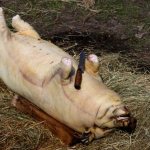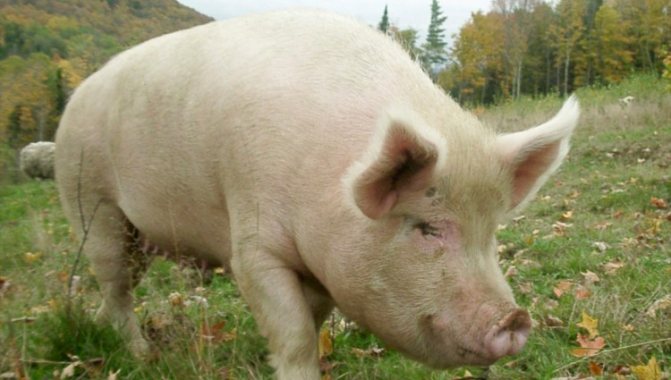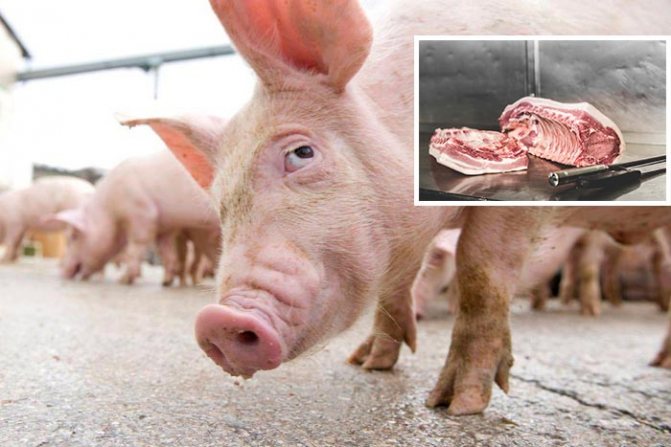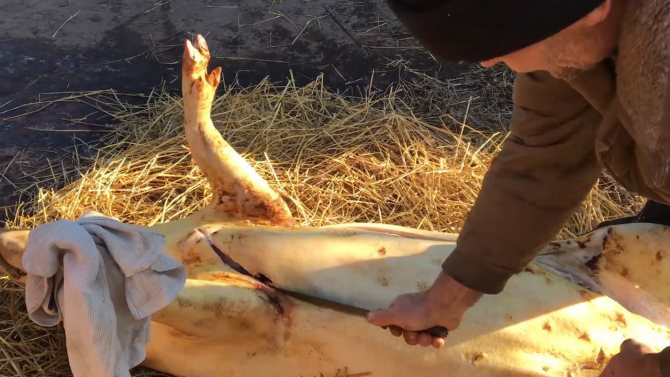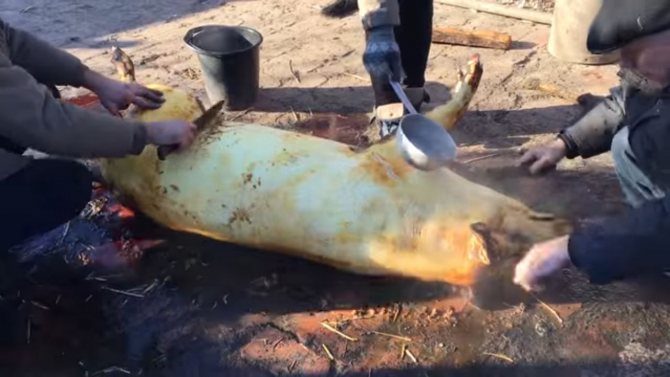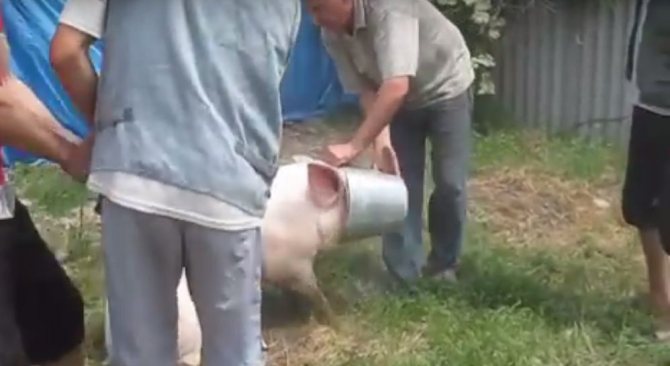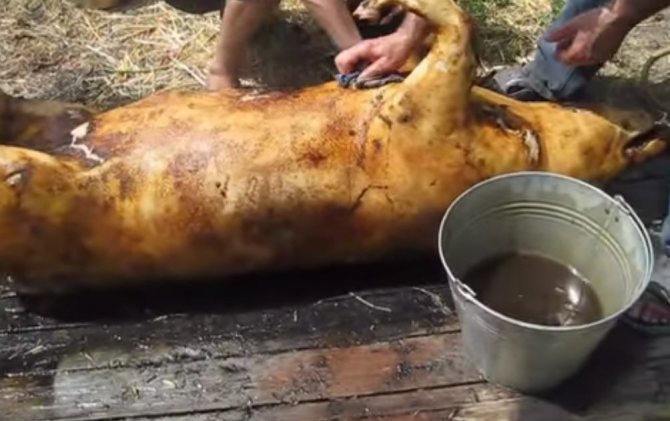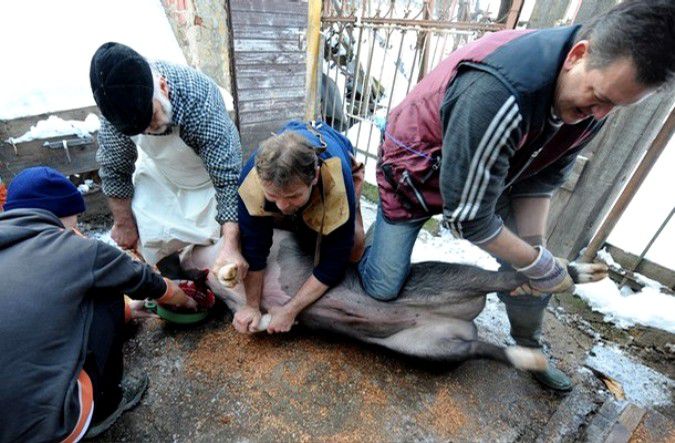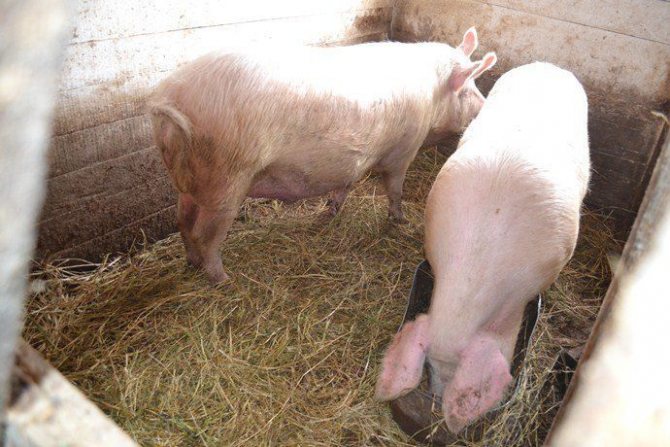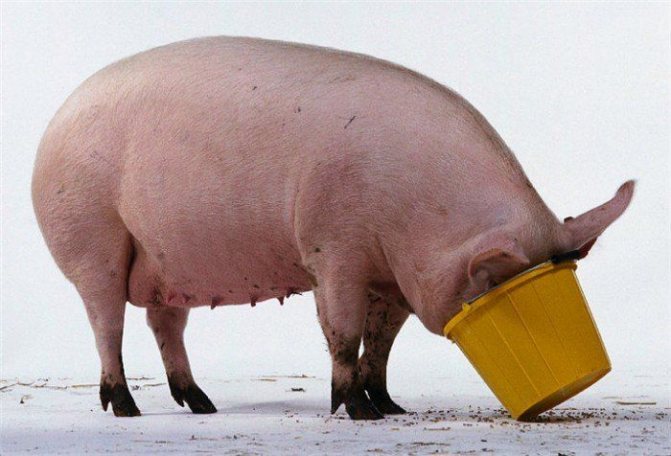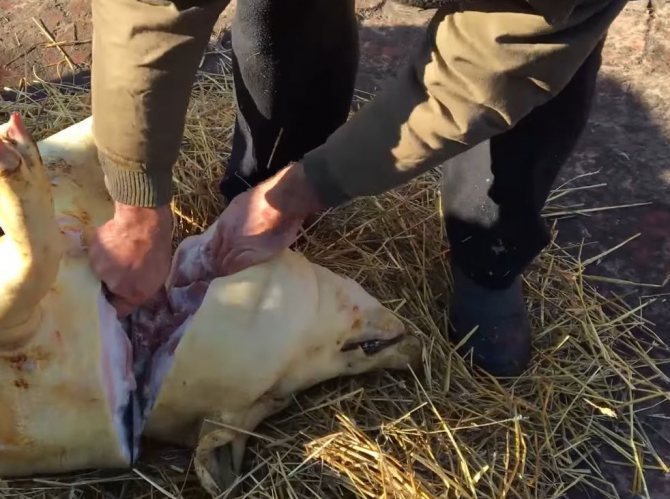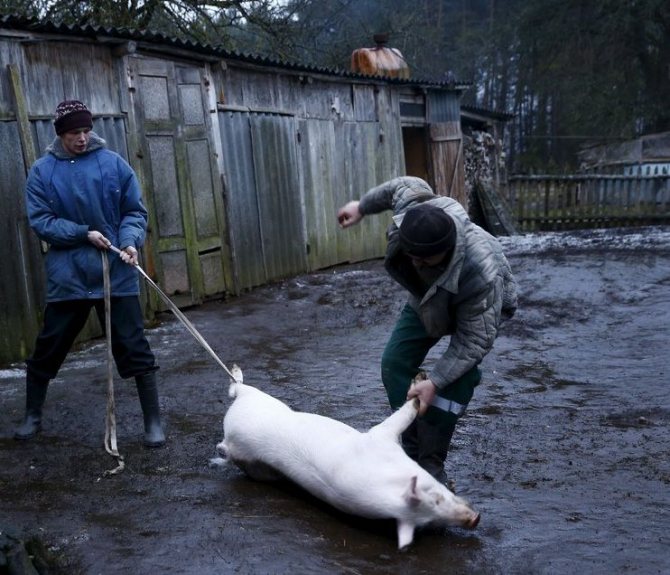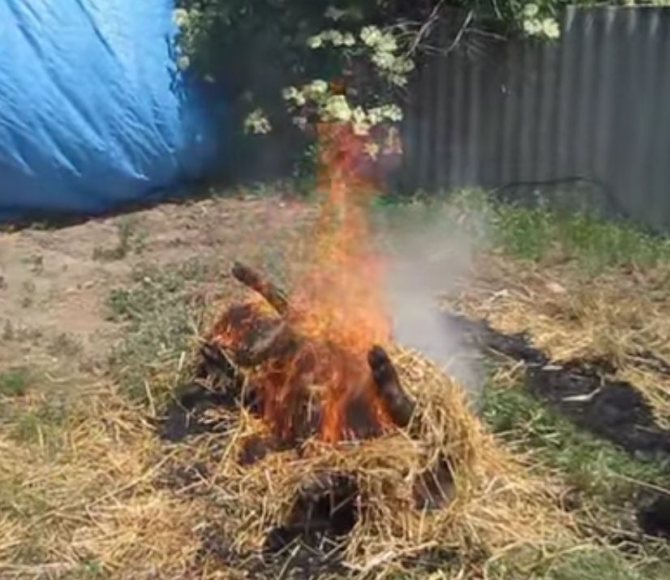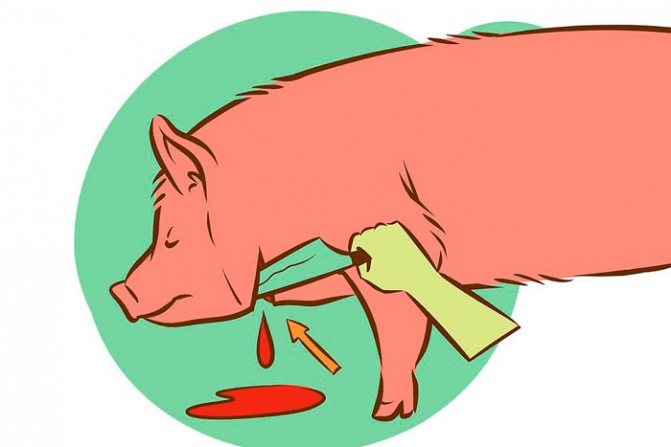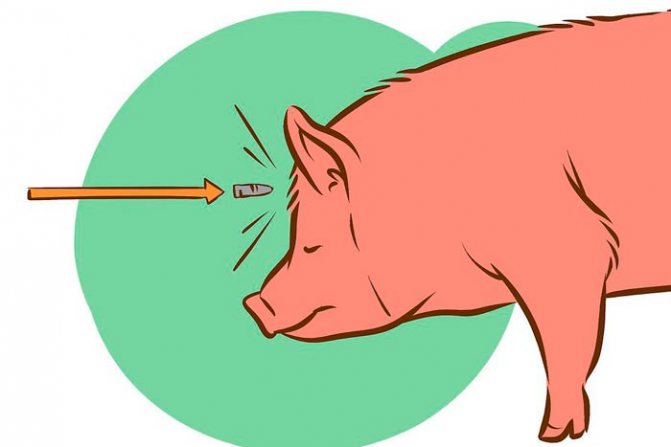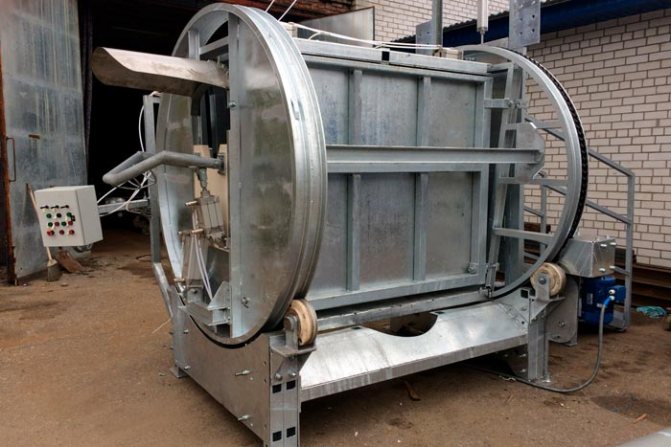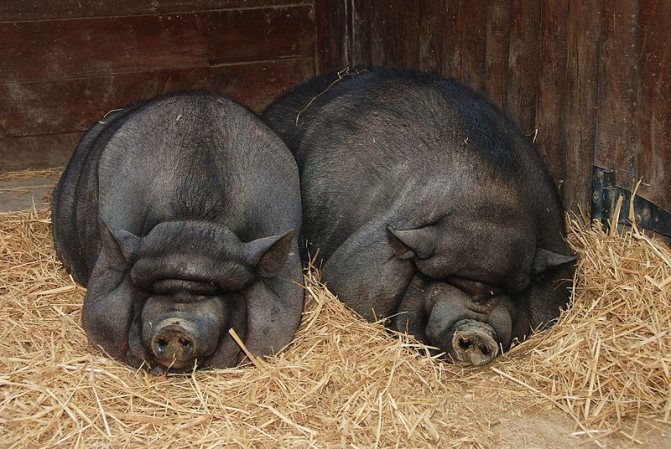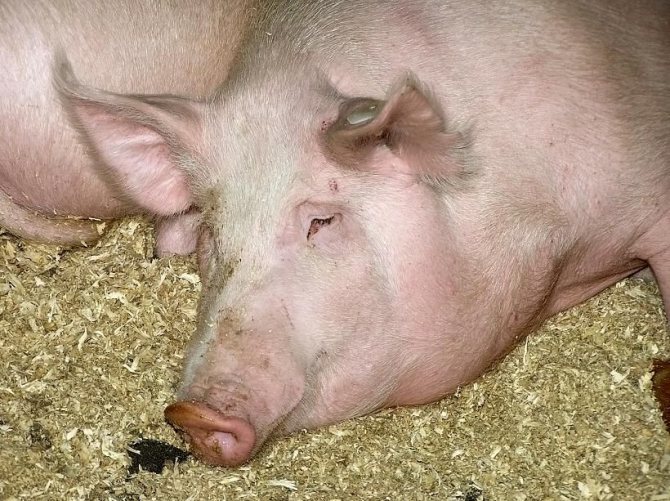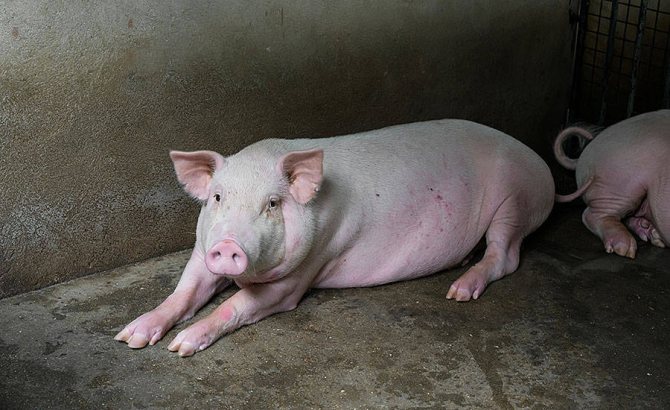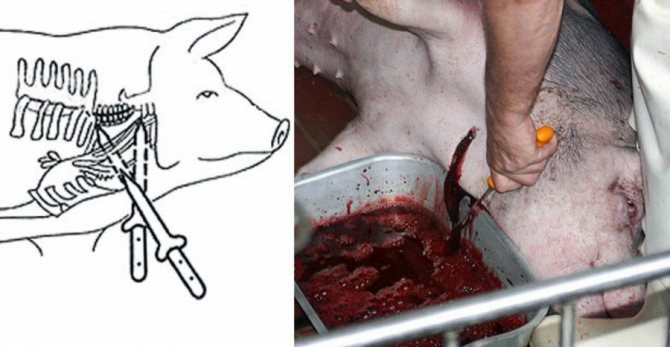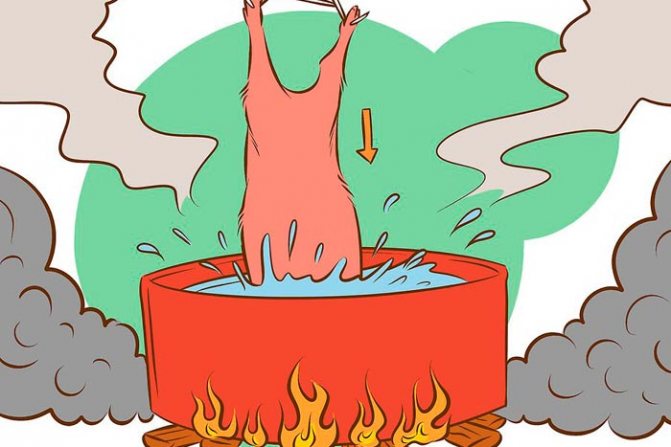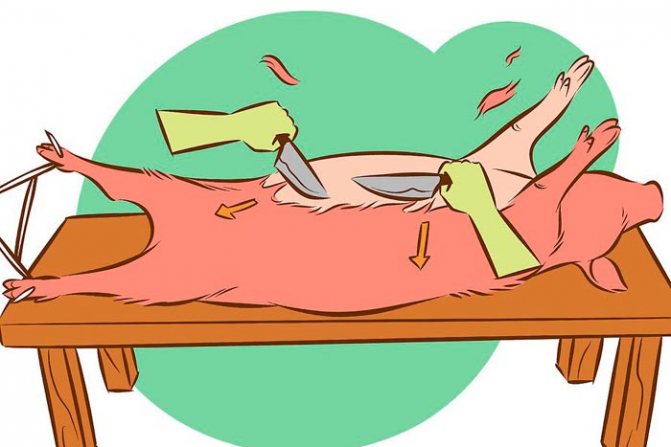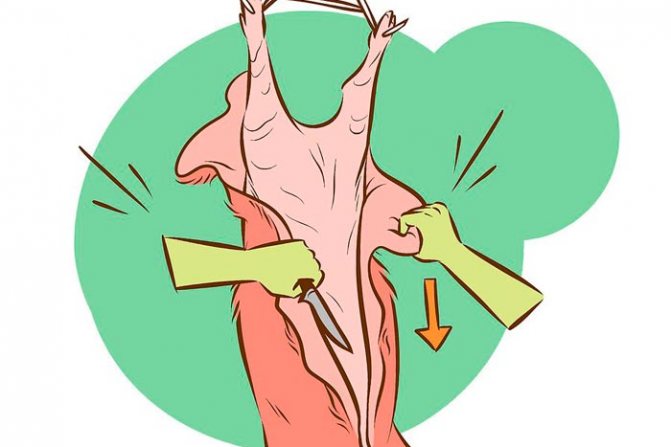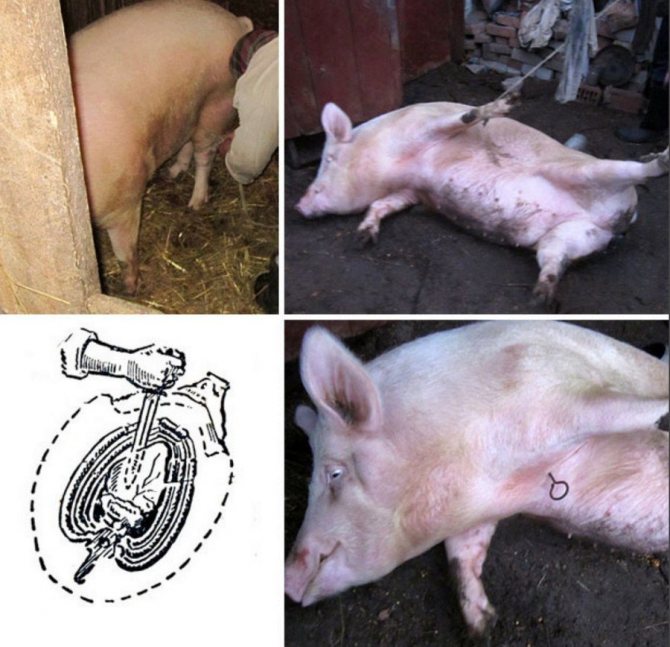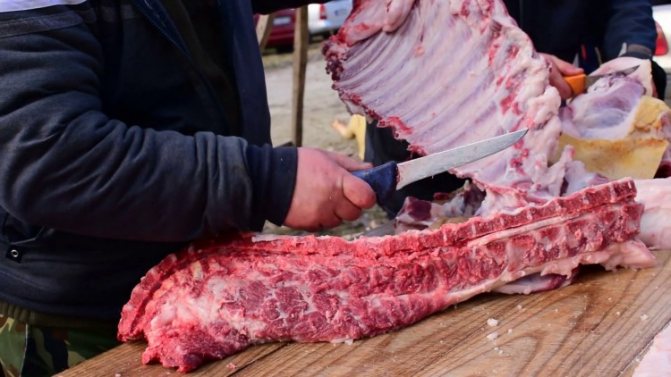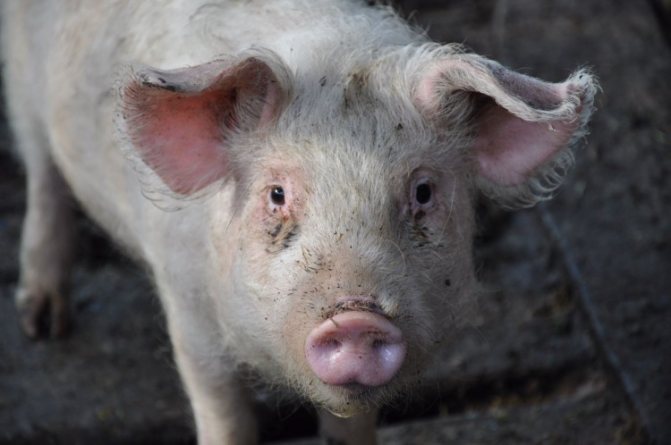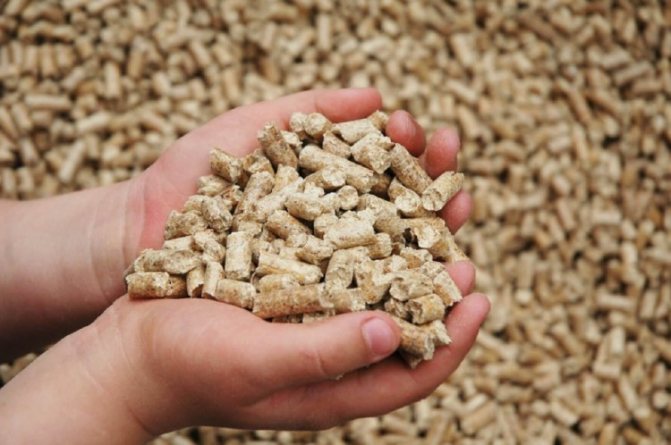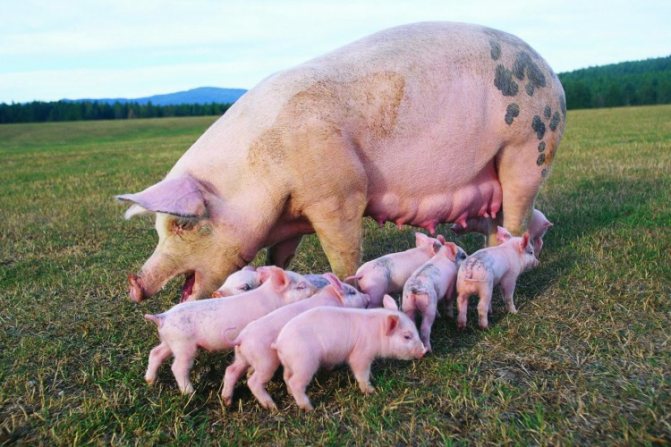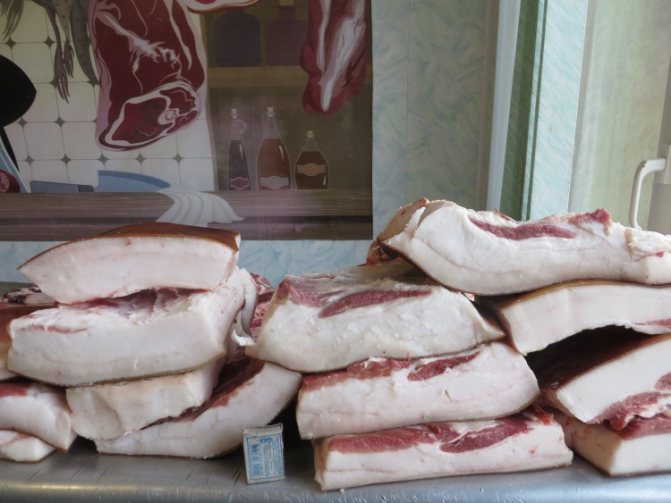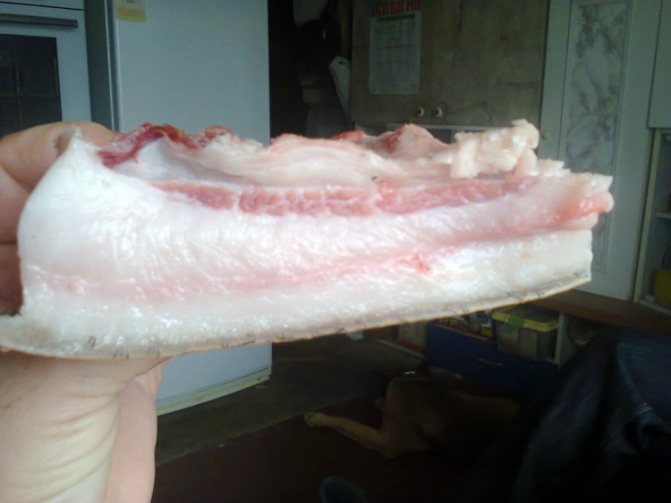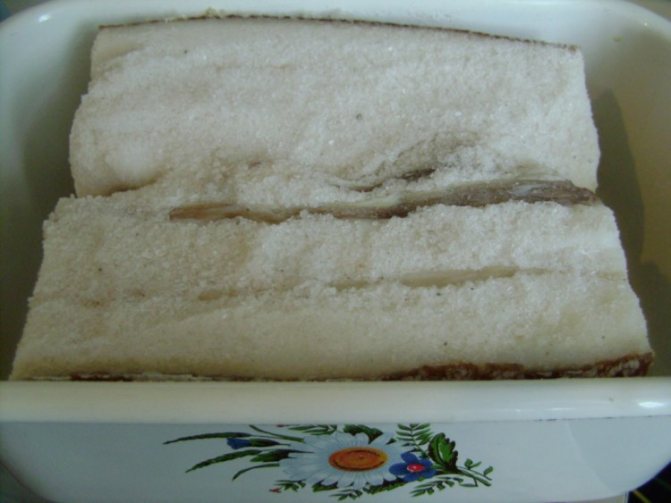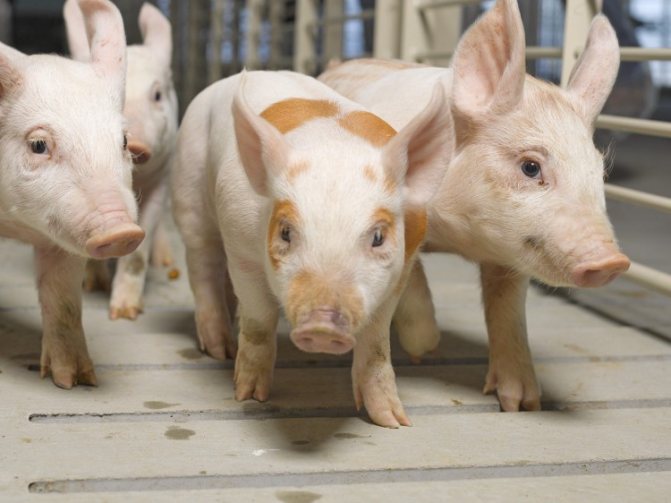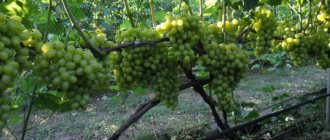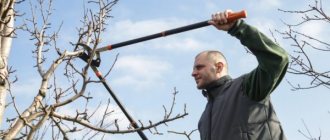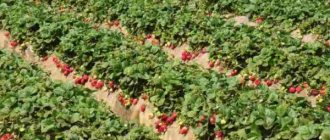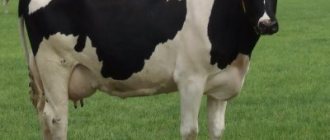Everyone who raises pigs has to decide the question of slaughtering animals after fattening. There are three options: take the animal to the slaughterhouse, hire a specialist, or stab the pigs yourself. The third option is the most profitable in terms of saving money and time, but for this you need to have not only skill and physical strength, but also the appropriate knowledge. In addition, it is necessary to visit the slaughtering of pigs, and more than once, in order to visually study the technology from start to finish.
Slaughter of pigs
Slaughter time
The right time for slaughtering the animal is important. In most cases, pigs are sent for slaughter, whose weight has exceeded the 100-110 kg mark. Experienced farmers recommend doing this summer in the morning hours, when the heat and flies are not yet strong. It should be borne in mind that the whole procedure, including cutting the carcass, will last at least 3 hours, and if it is performed by a person for the first time, it will take even longer.
In winter, you can stab a pig at any time of the day. If the weather is rainy, it is better to postpone the event, although if a comfortable covered area is available, slaughter can be carried out. The physical condition of the animal must also be considered. Some time should pass after taking antibiotics or other veterinary drugs, anthelmintic and antiparasitic treatment. If the pig has recently been treated, it is important to adhere to the slaughter times recommended in the medication instructions.
Slaughterhouse of a meat-packing plant
At meat processing plants, animals are slaughtered and their carcasses are processed. These organizations are large (500 tons of meat per shift), medium (100 tons) and small (50 tons). The pig slaughtering technology is mechanized due to an almost continuous flow.
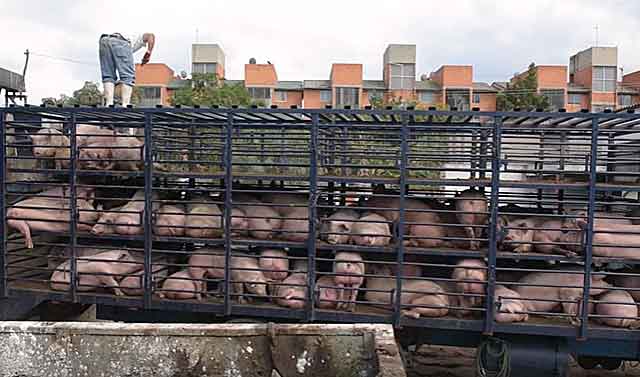
In such a production, there are usually many different departments, which are divided into dirty and clean. The first includes a workshop for pre-slaughter animals and primary processing of pigs.
Before pigs are slaughtered, they are kept in a slaughterhouse to recover from transportation from the pig farm. The meat-packing plant has all the conditions for keeping animals for 2-3 days - feeders, platforms, sheds. It is obligatory to have a quarantine zone, an isolator and a sanitary slaughterhouse (for sick animals).
If the production has several floors, then the upper floor should be allocated for the slaughterhouse of pigs. This links it to other items vertically using conveyors and pipelines.
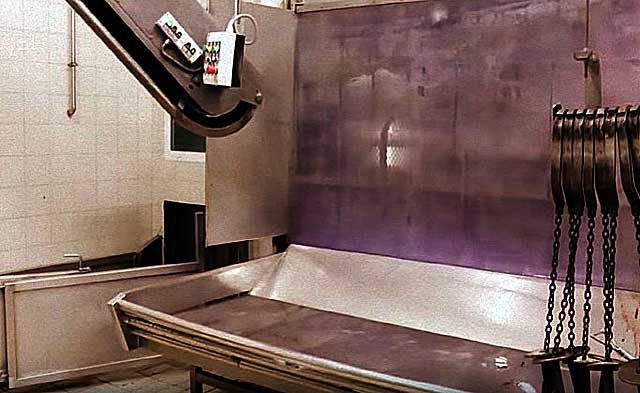

A pig slaughterhouse is a production facility and must comply with certain rules. Walls, ceilings, partitions, floors - everything is smooth, made of waterproof material. The surface of the flooring is built with a slope towards the drain. It is imperative to have a sewage system and a filter for wastewater treatment, as well as high-quality ventilation.
Can a pig be slaughtered when it is walking?
At the age of 4-5 months, female pigs reach puberty. At a certain time, once every 18-24 days, they have a hunt - a state when the hormonal background of the animal changes, and it is ready to mate. Experienced farmers recommend refraining from slaughtering the pig while it is walking. Under the influence of hormones, the quality indicators of meat deteriorate.
Hunting in pigs lasts about 2 days, but it is advisable to cut the animal at least 10 days after the end of estrus and no later than a week before the start of the next hunt. The state of arousal in a pig can be determined by the signs:
- She worries, rubs the back of her body against the walls, flips the inventory.
- Appetite decreases.
- The genitals swell a little, turn red.
- The udder and nipples also increase in size.
- The pig jumps on its relatives, regardless of their gender.
- The animal reacts especially sharply to the presence of a boar.
- When touching the lower back, the pig freezes in a covering position.
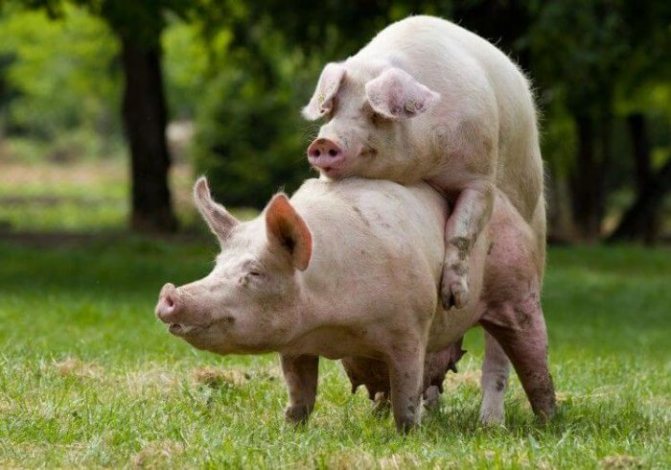

At the time of the hunt, slaughter is contraindicated.
Preparing a convenient site
Now we are talking about young piglets. How to slaughter a pig, we will say below. But regardless of age, size and gender, the process should not cause unnecessary suffering to animals and cause stress, which negatively affects the taste characteristics of meat.
Suckling pigs and pigs that have reached the age of 3-4 months differ significantly in their size and weight from adult pigs. They have much less physical strength, and during slaughter, the farmer may well do without the help of a professional butcher, who will definitely need to pay for the work or share the meat.
If for slaughtering an adult pig it is required to prepare an extensive slaughter area, then a small piglet can be slaughtered in the backyard of the farm. If other inhabitants of the pigsty see the slaughter process, then they will definitely start to get nervous and lose their appetite. The rate of weight gain by them will sharply decrease, and toxic substances will begin to accumulate in their muscle fibers, which reduce the taste characteristics of meat.
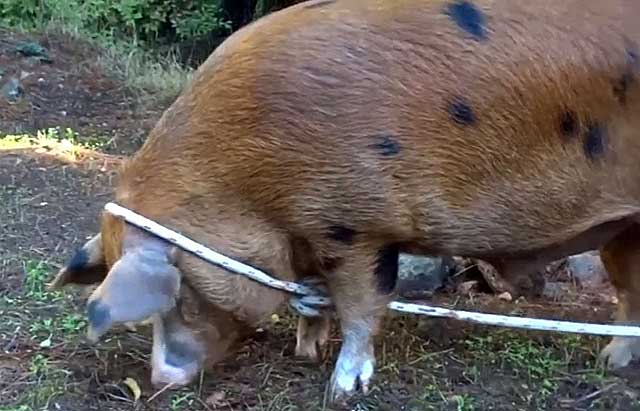

Preparatory stage before slaughter
Having planned the date of slaughter, it is necessary to invite a veterinary worker to the farm to inspect the animal. This measure will make it possible to legally sell meat in the future. The veterinarian will issue a document giving the right to sell products from a slaughtered pig.
Preparation for slaughter includes a number of other measures. To cleanse the intestines of the animal, about 12-18 hours before the procedure, they stop feeding it. It is allowed to give only water, however, 4 hours before slaughter, the pig should not receive any drink either. All these measures are aimed at improving the quality of meat. In addition, it is much easier to lure a hungry pig out of the pen by offering it food. It is most convenient to take the pig out of the pigsty backwards, throwing a bucket over its head, thereby limiting the view.
Reference. An animal kept in a confined space must first be washed using warm water and a brush.
Slaughtering process
The goal of the farmer is to try to kill the animal quickly and without suffering. A strong fright should not be allowed, since the released hormone adrenaline will give the meat an unpleasant taste. There are several ways to slaughter a pig:
- The first involves fixing the body and delivering a precise and powerful blow to the neck or heart.
- In the second method, the animal is first stunned by inflicting a strong blow with a blunt object in the frontal part of the head, and then either the carotid artery and jugular vein are cut, or the heart is pierced.
It is important to slaughter the pig correctly, choosing the option that is more convenient for you. Using the first method of slaughter, it is necessary to enlist the help of another person, since it is not easy to fix an animal, the mass of which sometimes exceeds 200 kilograms. There are cases when a pig, distraught with fear, having received a fatal blow to the neck or heart, breaks loose, runs in agony around the courtyard and squeals violently. In a fit of rage, she is capable of injuring a person.
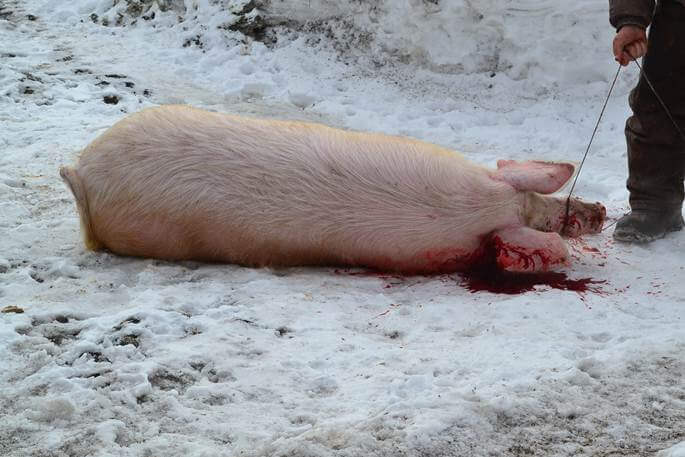

Pig slaughter
The second option is much simpler than the first, and a woman can cope with it if necessary, since after a blow to the head, the pig turns off, but does not die. Further, she does not feel fear and pain, which greatly facilitates the slaughter procedure.This method is safer, since a stunned pig cannot harm a person.
Let's consider the slaughtering process at home in more detail.
- A dish with food is placed in front of the pig, this will help distract it.
- A rope is thrown onto the hind limbs and pulled together, after which the animal falls. You can throw the rope over a strong crossbar and pull it towards you, so that the pig will rise up in a suspended state.
- When the mumps calms down, the jugular vein and carotid artery are quickly cut with a precise blow (the knife is inserted into the area of the neck and chest junction on one side).
- If the farmer needs blood for further processing, it is necessary to take care of the collection container in advance.
Important! The knife should not be removed from the wound until the animal has calmed down. Then it is carefully removed so that the blood comes out.
Exsanguination
The carcass should be exsanguinated by carefully removing a knife or knitting needle from the wound. Some pig owners do not do this if they are not going to cook blood sausage, and after slaughter, they immediately start processing the carcass. However, if the meat is for sale, then the blood must be drained.
Blood flows best from the body through an opening in the neck when the carotid artery and jugular vein are dissected. In this case, the pig can lie on its side or be in a suspended state. A clean dish (scoop or bowl) is placed under the stream. After a puncture of the heart, some of the blood remains in the sternum, therefore this method is less preferable.
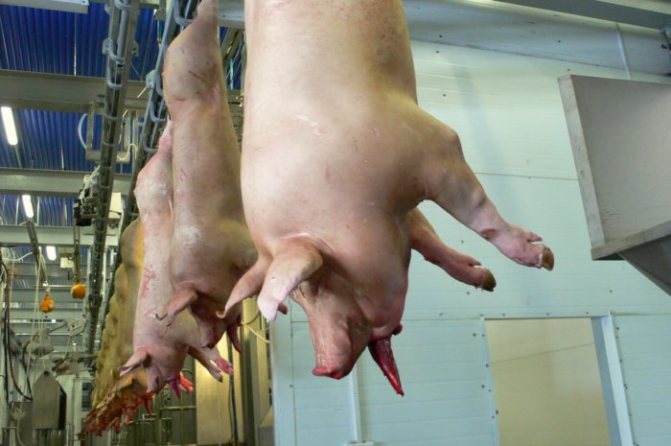

Pork carcass bleeding process
Pork storage after slaughter
In the future, it is best to store the meat in a refrigerator or icebox in an enamel bowl with a tight lid. The meat can be frozen, and further stored in the freezer, and gradually defrost before use.
Pork can also be stored in one of the following ways (Figure 7):
- Prepare corned beef. The meat is generously rubbed with salt and placed in barrels, jars or boxes, sprinkling the layers of meat with pepper and spices.
- In the same way, you can cook shpig - lard, salted in large pieces in a box.
- Ham can be prepared from lean pork by salting or boiling them. Also, meat can be baked and smoked.


Figure 7. Methods for storing pork: 1 - freezing, 2 - salting, 3 - bacon, 4 - cooking sausage
Sausages are also prepared from intestines, pieces of bacon and meat, which are further baked or fried. From the video you will learn how to quickly and accurately split a pork carcass to obtain marketable meat and high quality lard.
Cutting and processing of carcasses
After the end of the slaughter process, when the animal has stopped moving and the blood has completely left, you can proceed to the primary processing of the carcass. If there is no need to remove the skin, then firing is performed. To do this, use:
- burner;
- blowtorch;
- straw.
The skin is completely burned with fire, after which the soot is scraped off with a scraper, and the skin is washed with warm water.
If they plan to remove the skin from the carcass, then you can do without firing... It is necessary to make shallow (about 0.5 cm) incisions behind the ears, as well as around the head. Starting from the neck, an incision is made along the entire body along the nipple line. In the genital area and anus, the skin is removed.
Skin is removed, starting from the hind limbs, gradually moving higher. It is pulled a little and separated from the layer of bacon with a sharp knife. Then the skin is left rolled into a roll for 30 minutes to cool down, after which it is laid out on a clean surface and treated with coarse rock salt according to the principle - 3 kg of salt for every 10 kg of skin. Then it is rolled up again and left for 3 weeks to be salted in a cool room.
Next, they start cutting the carcass. This process goes like this:
- Separate the head from the body with a hatchet.
- An apron is cut out on the belly.
- With an ax, the chest is divided into two parts.
- The end of the esophagus is tied up and removed, then the heart, lungs, and diaphragm are removed from the carcass.
- They begin to extract the intestines and stomach.
- Now you need to separate the liver, taking care not to damage the gallbladder.
- Then the kidneys with the bladder are cut off.
- At the end of cutting, the carcass is wiped with a clean cloth and divided into two parts along the body.
Attention! You cannot wash the carcass with water, otherwise the meat will deteriorate faster.
Next steps
The processing of pigs and piglets proceeds to the next stages, at which meat carcasses and food and technical products are obtained. This means that the skin of the exsanguinated animal is processed, the internal organs are pulled out and the pork body is cut into pieces. This is how it goes.
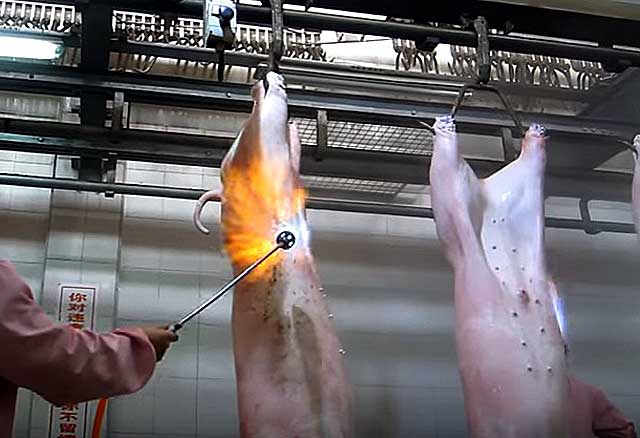

The pig carcass is bled, but it is considered dirty. It is washed in a special apparatus. After that you need to remove the bristles. The carcasses are scalded in steam baths with hot water. At a temperature of 59-64 degrees, the process takes up to 7 minutes. This will allow you to easily remove stubble and hairs later, as the skin softens.
After that, the carcass is immersed in a scraper where the bristles are removed and washed off with water. This takes 25-30 seconds. However, it is impossible to cleanse the pig's body so perfectly, so the next step is drying and scorching. There is a lot of additional information in the article "Singing Pigs".
Then the carcass is cleaned of burnt bristles and sent to the removal of internal organs. After exsanguination, this is done no later than 45 minutes.
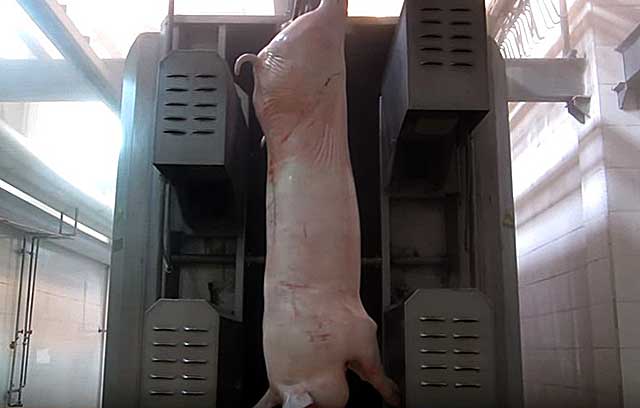

If sows had to be slaughtered, and embryos were found inside them, they are removed and sent to the workshop for technical products. It's the same with the udder. When the guts are removed from the pig, the walls of the intestines, stomach, urinary and gall bladders must not be damaged. If the fluids present in these organs get on the meat, it will spoil its taste.
When the carcass is fully prepared, it begins to be peeled and cut into pieces, which will later be processed, branded and sent to the refrigerator.
Slaughter methods
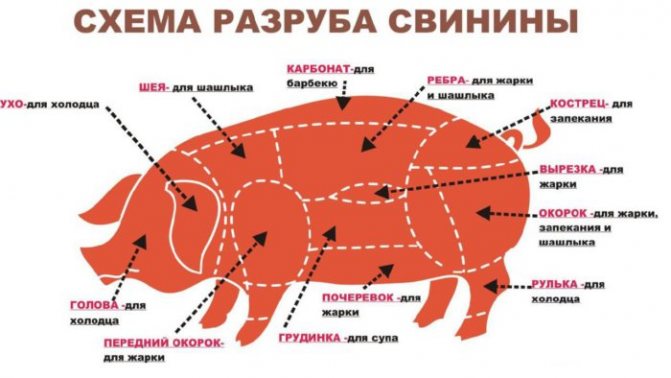

Pork cutting diagram
In order for the meat to meet quality standards, it is important to slaughter the pig correctly. There are several ways to slaughter:
- to the neck;
- in the heart.
Both methods are applicable to both adults and piglets.... Each farmer chooses a more convenient option for himself. The first is more popular among livestock breeders, since after a blow to the neck, the carcass bleeds better - the blood leaves the carcass when the heart is beating. Naturally, this method involves stunning the pigs beforehand. Let's consider each slaughter method separately.
To the neck
Pig slaughter at home is often done in the neck, where the largest arteries pass. In order to immobilize the animal, its hind limbs are tied or a rope is tied to its right leg. Further, they take a sledgehammer or an ax and with a blunt part inflict a powerful blow to the area above the eyes or to the back of the head.
When the pig falls, the point of a knife is inserted into the side of the neck where it meets the breast. After cutting the carotid artery and jugular vein, a container is placed under the trickle of blood to collect it. This method is considered safer for humans and more humane for animals.
Attention! Bleeding occurs best when the heart is working, which is why the neck method is popular with farmers.
In the heart
A slaughter in the heart can be performed with or without preliminary stunning. For an accurate hit, you need to knock the pig on its right side. To do this, they grab her by the hind right limb or use a rope. Then the edge of the knife is stabbed into the armpit area between the 3rd and 4th ribs. The knife cannot be removed until the pig stops moving.
Attention! Having no experience in slaughtering pigs, it is worth inviting a knowledgeable person, because a blow to the heart must be inflicted with maximum accuracy.
Piglet
If you need to slaughter a pig, you can hang it at a comfortable level above the ground by tying the hind limbs beforehand. Then they act in any way - they strike him in the heart or neck. A piglet is easier to handle than an adult, because its body weight is less.
A few tips for beginners
The main problem for beginners when slaughtering an animal is pity. In no case should you get used to a domestic pig. It must be clearly understood that it is growing for further slaughter. Superfluous feelings during killing will not allow you to strike a confident decisive blow, thereby bringing unnecessary suffering. Also, a wrong blow will inflame the pig, it will rush about in a rage, biting offenders.
Important! Do not give animals nicknames and consider them as members of your family. In the future, this will help to avoid depression and insomnia after their slaughter.
To slaughter a pig easier, it must be immobilized. Sometimes the usual binding is not enough. Here, stunning comes to the rescue by hitting the forehead with a sledgehammer or with the help of an electric current. Correctly stunning a pig before slaughter is a guarantee of ease in further actions. The immobilized animal is still alive, so there will be no problems with removing blood during slaughter.
Don't underestimate the importance of bleeding your mascara quickly. The faster this procedure is carried out, the higher the quality of the final product will be. The ideal time is considered to be 3 minutes from the moment of death, but in some cases 5 minutes is allowed. A delay in the removal of blood leads to irreversible consequences - the processes of coagulation and decay begin very quickly in it.
Required inventory
Consider what tools a farmer will need to slaughter a pig and then cut the carcass.
- Strong rope.
- Sledgehammer or ax.
- Sharp long knife.
- Scraper.
- A burner is required for firing.
- A clean container for collecting blood.
- Clean rags - gauze, cotton cloth.
- Warm water.
- A tabletop or large wooden cutting board.
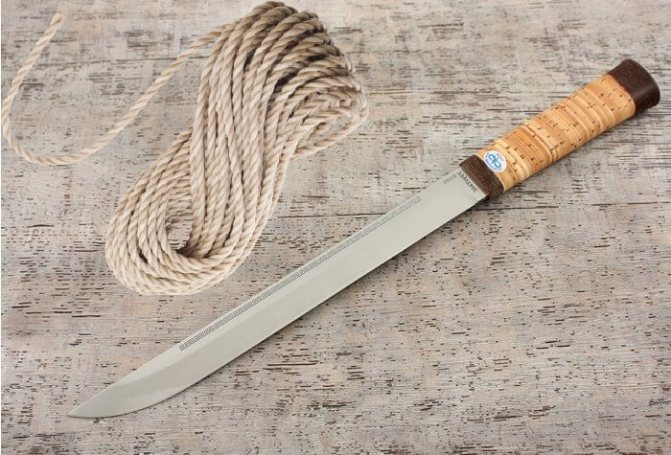

Rope and knife for slaughtering a pig
It is important to properly prepare for slaughtering a pig - agree with a veterinarian about a visit, enlist the support of a knowledgeable person, prepare the necessary equipment. The slaughter procedure must be carried out as quickly and painlessly as possible, taking care that the animal is not frightened, because the quality of the meat will depend on this. Carcass cutting is done quickly, without distraction, so that the product does not deteriorate. By following these rules, the farmer will be able to get a good profit from his event.

